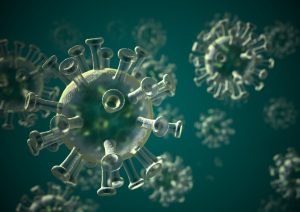The media reported last week that genes from Neanderthals protect many of us against severe Covid-19. Those genes actually come from Denisovans too: another early human species. Unfortunately, a different set of Neanderthal genes increases our chances of serious Covid. This post goes behind the news and looks at our connection to these two prehistoric creatures, as well as their genes’ impact on Covid risk. It also looks at those genes’ frequency among modern ethnic groups.

Neanderthal woman (from the Neanderthal Museum)
Neanderthals and Denisovans

Denisovan girl (by Maayan Visuals)
We’ve known about Neanderthals since the 1860s, and archeologists have found hundreds of their fossils and tools. Denisovans, however, were only identified in 2010. Much about them remains unclear, and we only have a handful of fossils. But we know they had bigger molars than Neanderthals or Homo sapiens — more like earlier members of the Homo genus. We also know Denisovans shared the Neanderthals’ massive build, flat noses, protruding jaws and brow-ridges, sloping foreheads, and flat and long heads. Those oddly shaped Neanderthal heads contained brains bigger than ours, so Denisovans may have had bigger brains too. We don’t know whether that means these other species were smarter.
Fortunately, we have both species’ DNA, extracted from the fossils.
Classification and Hybrids
The Neanderthals and Denisovans are classified Homo neanderthalensis and, tentatively, Homo denisova. They evolved in Eurasia from a shared ancestor called Homo heidelbergensis. We’re their smaller, weaker African cousins. Our species probably descends from Homo heidelbergensis too, but the Homo sapiens branch of the tree diverged earlier. Still, we were close enough to cross-breed and produce fertile offspring.
Members of different species usually can’t do that: they can’t produce fertile offspring. Horses and donkeys can’t, even though they’re closely related — members of the Equus genus. Cross-breeding them produces sterile mules (and hinnies). The same goes for lions and tigers, members of the Panthera genus, which produce sterile hybrids called ligers and tigons. So we must have been very closely related to Neanderthals and Denisovans — closer than horses and donkeys or lions and tigers. It’s not unprecedented. Wolves and coyotes can produce fertile offspring. So can cows and buffalo, as well as servals and housecats, which have been bred to produce a beautiful spotted pet called a Savannah cat. In each case, some of the hybrid offspring may be sterile, particularly among the males. But enough can reproduce to pass on hybrid genes.
Prehistoric Encounters and Modern Ethnic Groups
We met Neanderthals and Denisovans when our species spread out from Africa into Eurasia, around 60,000 years ago. So their genes occur among Europeans and Asians. They’re also found among Native Americans, Australian Aboriginals, North Africans, and all other peoples who migrated through Eurasia before reaching their long-term homes. Europeans and mainland Asians average something like 2% Neanderthal, while Australian Aboriginals, Polynesians, and Indonesians range from 1% to 6% Denisovan. And many in those populations have some of both.
Only Sub-Saharan Africans lack significant Neanderthal or Denisovan genes. That’s because their ancestors did not migrate through Eurasia. Prehistoric Africans may have interbred with non-sapiens too, but those would’ve been African species, so far unidentified.
Of course, members of every ethnic group usually have some ancestors from another group. So as they say with medicines, individual results may vary.
The Hybrids’ Helpful Haplotypes
Last month, scientists announced a haplotype — a cluster of genes — that helps destroy RNA viruses, including Covid-19. Each copy of the haplotype reduces the odds of severe Covid by 22%. That haplotype occurs in Neanderthals and Denisovans but not in early Homo sapiens. Our species got it from the other two species — from cross-breeding.
DNA is rarely simple, however, and neither is immunity. Scientists have also identified a Neanderthal haplotype that increases the risk of severe Covid-19. Those genes double our chances of hospitalization. They don’t seem to come from Denisovans.
Today’s Ethnic Groups and Natural Selection
The currently helpful haplotype appears in about 50% of non-Africans. That’s a lot for genes from Neanderthals and Denisovans, since each represents such a small share of our genetic inheritance. So that haplotype probably protected us against Covid-like viruses in the past, leading to heavy selection for those genes. In fact, the haplotype’s frequency apparently surged during just the past thousand years (in addition to earlier increases). That suggests we faced a Covid-like disease recently: during the Middle Ages (the Postclassical period) or later.
The currently harmful Neanderthal haplotype appears in about 65% of Southeast Asians and 16% of Europeans. It’s mostly absent from East Asians and of course from Africans. That haplotype probably protected against diseases faced by Southeast Asians in the past and so grew more common there. But its vulnerability to Covid-like diseases led to selection against those genes in other regions.
Images:
- Neanderthal woman, © Stiftung Neanderthal Museum
- Denisovan girl, graciously licensed by Maayan Visuals and © Maayan Visuals
- Phylogeny of the Homo genus, based on Stringer, C. (2012). “What makes a modern human”. Nature 485 (7396): 33–35. doi:10.1038/485033a, with modifications, by Conquistador and Dbachmann, provided through Wikimedia Commons and licensed under the Creative Commons Attribution-Share Alike 4.0 International license.
- This is a representation of what the Covid-19 virus would look like under a powerful microscope, by HFCM Communicatie, licensed under the Creative Commons Attribution-Share Alike 4.0 International license.
© 2021 by David W. Tollen. All rights reserved.



0 Comments